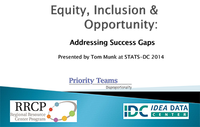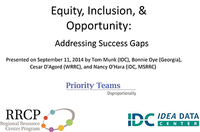As a part of developing their SSIP Phase I, the South Carolina Department of Education chose to use the IDC Equity, Inclusion, and Opportunity: How to Address Success Gaps, Rubric to inform their work. SC state staff developed the SC SSIP Partners' Inventory by reformatting content in the Success Gaps rubric, breaking apart some of the more complex components of the rubric into more concise elements that could be rated more easily on a Likert-type rating scale. The intent of the SC Partners Inventory was to provide staff with a quick first look at the success factors, before later completing the entire Success Gaps rubric with their teams in their district.
In South Carolina’s work with their school districts, the purpose of school district personnel completing this inventory was twofold. First, considering these questions enhances the framework for thinking about how the district operates according to five specific domains, referred to as “success indicators.” Second, responses indicate areas of strength and challenge that can help define a specific area of opportunity for receiving ongoing support for program improvement and, subsequently, promote an improvement in teaching and learning in districts that helps meet the target identified in the State’s SIMR.
The South Carolina Department of Education is continuing to use the South Carolina SSIP Partners' Inventory and the IDC Equity, Inclusion, and Opportunity: How to Address Success Gaps, Rubric with their districts identified for focused SSIP Phase II work.
Resource Files & Links
Companion Resources
These are resources that supplement the resource above.
Format: Guides, Papers, and Reports
Equity, Inclusion, and Opportunity: Addressing Success Gaps, White PaperThis white paper focuses on elements of equity, inclusion, and opportunity that can minimize or eliminate success gaps among different groups of students. It provides the research-based background that guided development of a complementary rubric that schools or districts can use to systematically examine the root causes of success gaps among groups of their students. The white paper has been updated recently and now includes considerations for children as young as preschool.
Format: Guides and Briefs
Success Gaps Rubric: Addressing Equity, Inclusion, and OpportunityThis rubric allows a team of users from a district or school to systematically examine the root causes of success gaps among groups of students by focusing on equity, inclusion, and opportunity. The recently updated rubric now includes considerations for children as young as preschool age. A complementary white paper provided the research-based background that supported development of the rubric.
Related Content
Format: Presentations
Equity, Inclusion and Opportunity: Addressing Success GapsThe presentation introduces a research-based guidance document and self-assessment rubric designed to help districts and schools identify the root causes of "success gaps" (for example, in test scores, suspension or graduation rates, or course credits) for some groups of students, thereby helping schools to improve and equalize results for all students.
Format: Presentations
Equity, Inclusion, and Opportunity in Special EducationIn this webinar, which IDC staff presented for the University of Tennessee’s Boling Center for Developmental Disabilities, we first discuss the requirements in the IDEA related to disproportionality, describe methods for calculating disproportionality, and present data, both at the national level and for the state of Tennessee. The second part of the webinar introduces a research-based guidance document and self-assessment rubric designed to help schools and districts identify the root causes of "success gaps."
Format: Presentations
Equity, Inclusion, and Opportunity: Addressing Success Gaps via the SSIP ProcessPresenters introduced a research-based guidance document and self-assessment rubric designed by OSEP's Disproportionality Priority Team to help districts and schools identify the root causes of "success gaps" for some groups of students, thereby helping to improve and equalize results for all students. As an example, presenters used Georgia's SSIP process, focused on graduation for students with disabilities.
Format: Presentations
Equity, Inclusion, and Opportunity: Getting SSIP Results by Addressing Success GapsThe presentation provides a self-assessment rubric that can help states and local districts view their school/district programs and practices with an "equity" lens and help states and LEAs understand the reasons for discrepancies in outcomes between certain groups of students. Helpful handouts are included.







